Much of the information on this page can be found in resources from BADIL, the Resource Center for Palestinian Residency & Refugee Rights, and from American Muslims for Palestine. See these materials in the Resources listed on this page. However, source text has been adapted and all emphasis with bold text, italics and underlining is added.
![]()
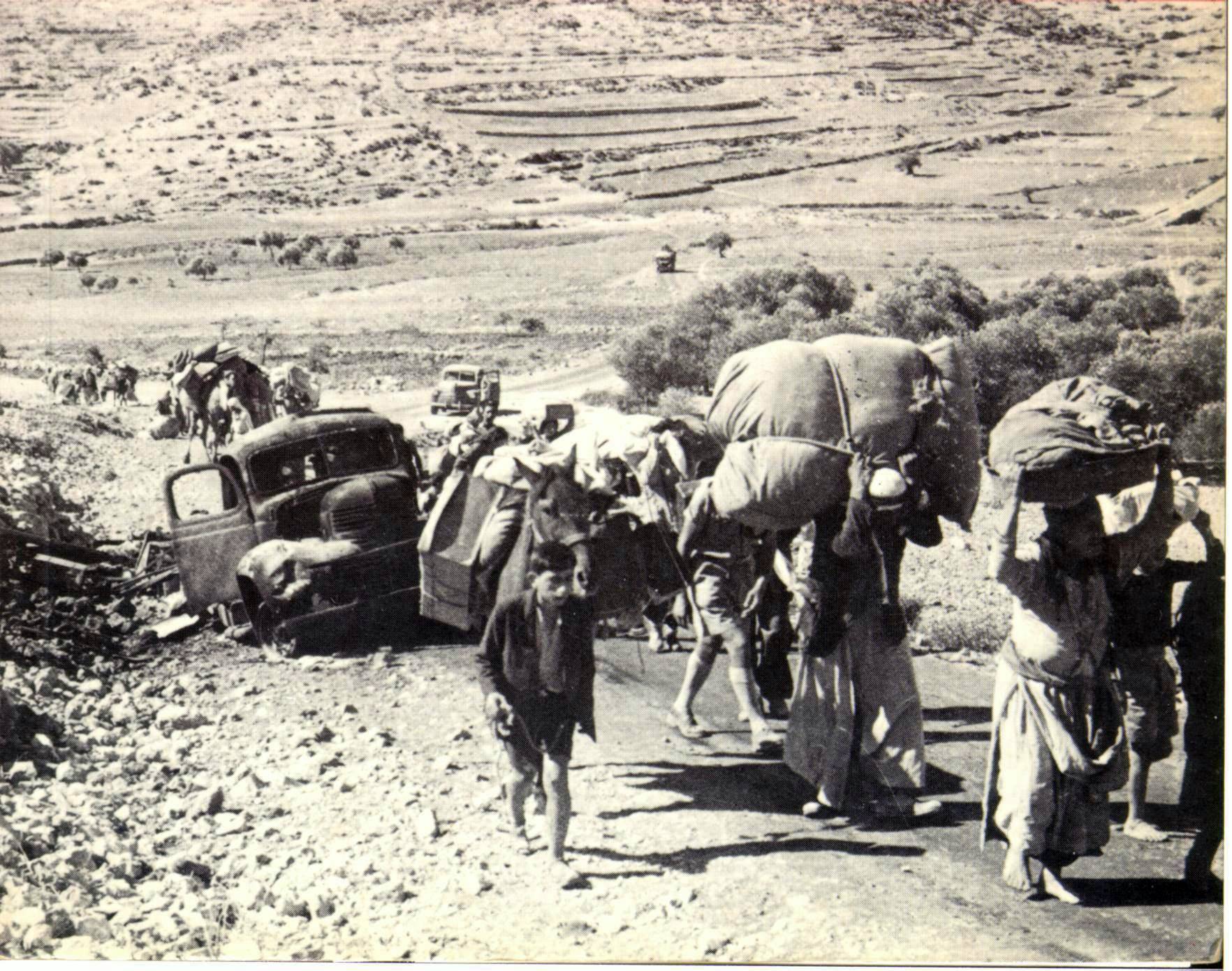 “In Plan Dalet, adopted in March 1948 by the high command of the Hagana (the main Jewish underground in the pre-state days), the Israeli objective of 1948 is clear. The goal was to take over as much as possible of the territory of Mandatory Palestine and remove most of the Palestinian villages and urban neighbourhoods from the coveted territory which would constitute the future Jewish state…. All these characteristics… can only be attributed to an Ethnic Cleansing policy; namely a policy that, according to the UN definition, aims at transforming a mixed ethnic area into a pure ethnic space, where all means are justified. Such a policy is defined under international law as a crime against humanity which the [US] State Department believes can only be rectified by the repatriation of all the people who left or were expelled as a result of the ethnic cleansing operation.”
“In Plan Dalet, adopted in March 1948 by the high command of the Hagana (the main Jewish underground in the pre-state days), the Israeli objective of 1948 is clear. The goal was to take over as much as possible of the territory of Mandatory Palestine and remove most of the Palestinian villages and urban neighbourhoods from the coveted territory which would constitute the future Jewish state…. All these characteristics… can only be attributed to an Ethnic Cleansing policy; namely a policy that, according to the UN definition, aims at transforming a mixed ethnic area into a pure ethnic space, where all means are justified. Such a policy is defined under international law as a crime against humanity which the [US] State Department believes can only be rectified by the repatriation of all the people who left or were expelled as a result of the ethnic cleansing operation.”
Ilan Pappe, Israeli historian
Owing to the creation of the state of Israel in 1948, Palestinians make up the longest standing and largest group of refugees in the world. In fact, Palestinians account for over 70% of the world’s refugees. In 2008, the 60th anniversary of the Nakba (or ‘Catastrophe’) – the destruction of Palestine and the massive displacement of Palestinians by Israel in 1948 – two out of every five refugees in the world were Palestinian.
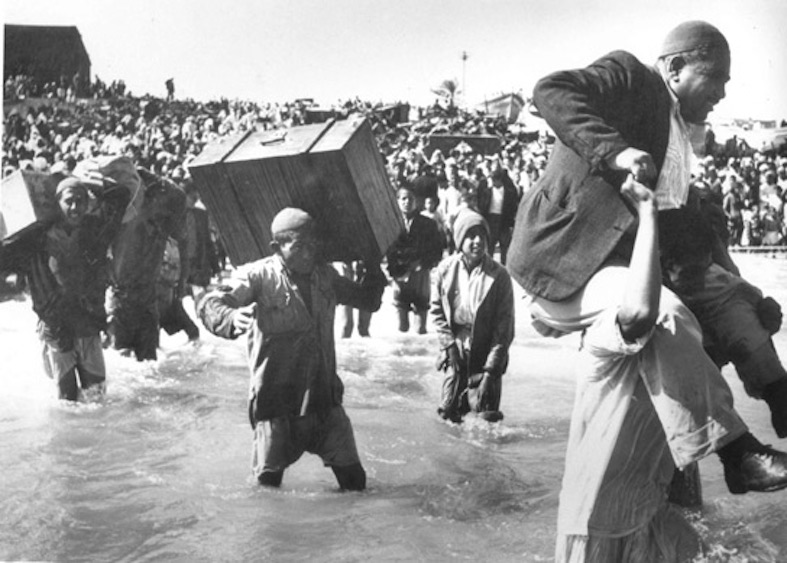 It started in 1948 with the creation of the state of Israel, which was carved out of 78 percent of historic Palestine. In the months leading up to the birth of Israel and for several months afterward, the Zionist paramilitary group the Haganah, the forerunner to today’s Israeli military, and terrorist groups like the Stern Gang and the Irgun depopulated and/or destroyed more than 500 Palestinian villages. More than 750,000 Palestinians became immediate refugees when they were forced into exile.
It started in 1948 with the creation of the state of Israel, which was carved out of 78 percent of historic Palestine. In the months leading up to the birth of Israel and for several months afterward, the Zionist paramilitary group the Haganah, the forerunner to today’s Israeli military, and terrorist groups like the Stern Gang and the Irgun depopulated and/or destroyed more than 500 Palestinian villages. More than 750,000 Palestinians became immediate refugees when they were forced into exile.
During the Six Day War in 1967, another 350,000 Palestinians were forced into exile when Israel invaded and occupied the West Bank and the Gaza Strip.
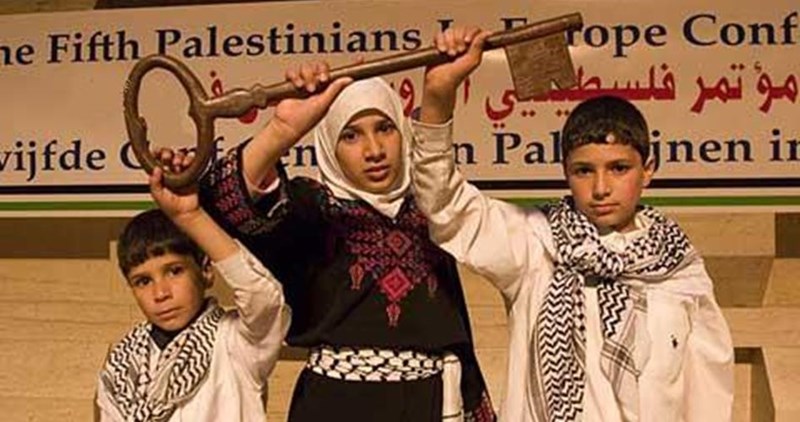
Because generations born to refugees also are considered refugees, the number of Palestinian refugees has surpassed the 7 million mark, according to the human rights organization the BADIL Resource Center. At the beginning of 2007, there were approximately 7 million Palestinian refugees and 450,000 internally displaced persons (IDPs), representing over 70% of the entire Palestinian population worldwide, which is 9.8 million.
Palestinian refugees include not only those who became refugees in 1948 and 1967, but also those who are neither 1948 nor 1967 refugees, but are outside the area of former Palestine and unable or unwilling to return owing to a well-founded fear of persecution.
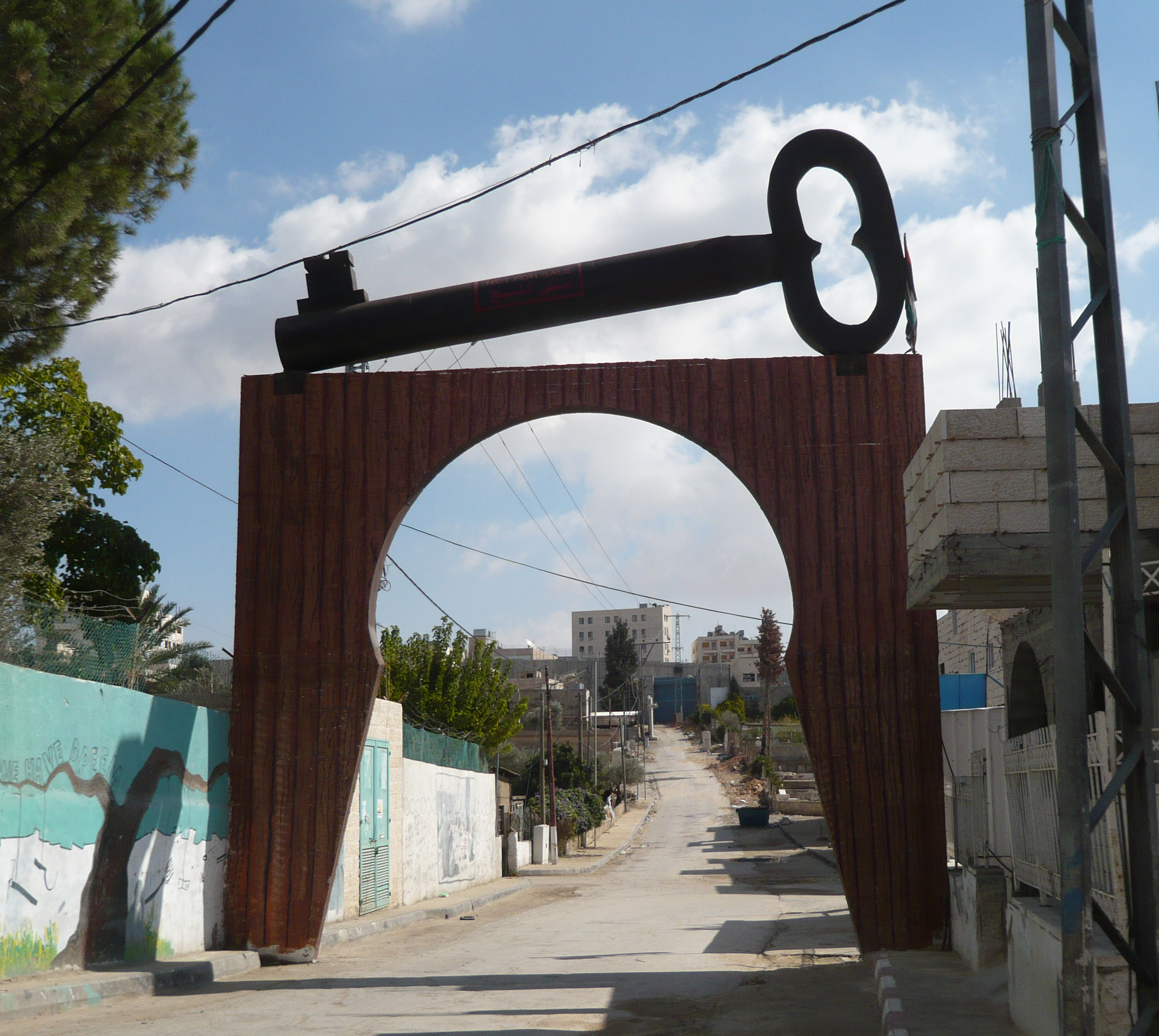
One-third of the registered Palestine refugees, nearly 1.4 million, live in 58 recognized refugee camps in Jordan, Lebanon, the Syrian Arab Republic, the Gaza Strip and the West Bank, including East Jerusalem.
Palestinian refugees in host countries are also vulnerable to forced displacement. For instance, as a result of the US-led aggression and occupation of Iraq since 2003, persecution has forced over half of the approximately 34,000 Palestinian refugees residing in Iraq to leave the country. Over 31,000 people were displaced from Nahr al-Bared camp in Lebanon in 2007 and most have not returned.
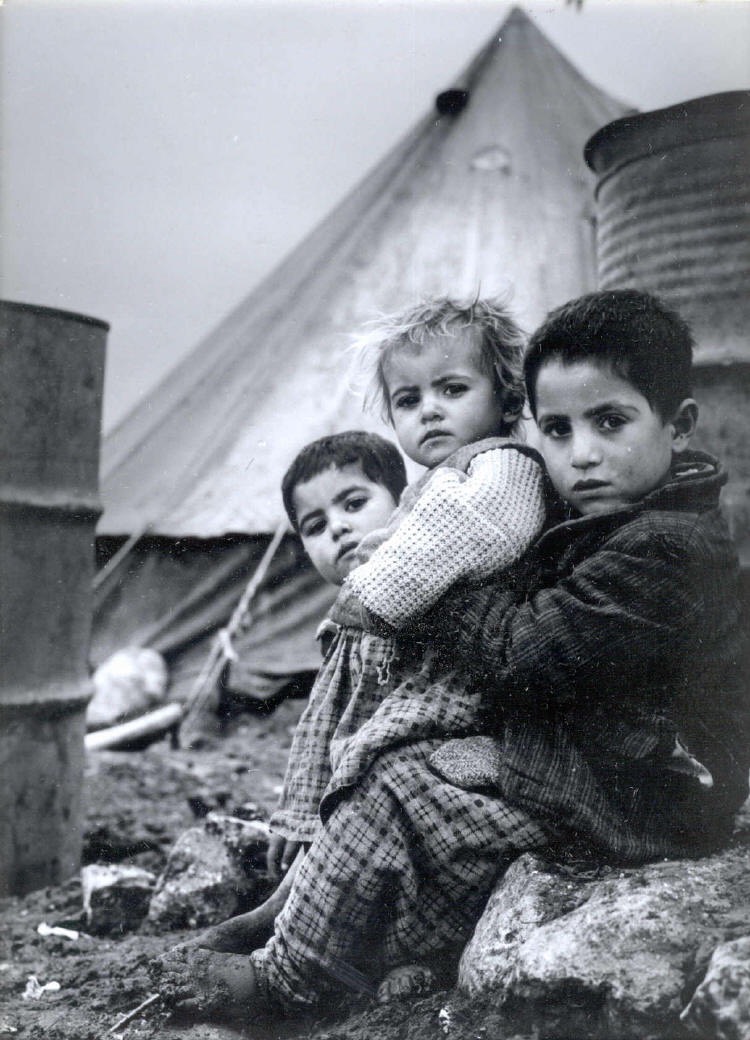 Current Israeli military laws are created to displace even more Palestinians. In this way, Israel makes the path clear for its further expansion and colonization of Palestinian land. Internal displacement continues unabated in the OPT today. Thousands have been forcibly displaced in the Jordan Valley as a result of closure, home demolition and eviction orders, and the threat of displacement hangs over those who remain. Similar patterns of forced displacement are found in Israel, where urban development plans for the exclusive benefit of Jewish communities are displacing indigenous Palestinian communities in the Naqab (Negev) and Galilee.
Current Israeli military laws are created to displace even more Palestinians. In this way, Israel makes the path clear for its further expansion and colonization of Palestinian land. Internal displacement continues unabated in the OPT today. Thousands have been forcibly displaced in the Jordan Valley as a result of closure, home demolition and eviction orders, and the threat of displacement hangs over those who remain. Similar patterns of forced displacement are found in Israel, where urban development plans for the exclusive benefit of Jewish communities are displacing indigenous Palestinian communities in the Naqab (Negev) and Galilee.
Although military invasions and home demolitions tend to be the most common method used to displace Palestinians, the Israeli government also revokes Palestinian residency rights and establishes illegal Israeli settlement systems that force indigenous Palestinians to leave their lands behind, according to the Norway-based Internal Displacement Monitoring.
Some Palestinians are even refugees in their own land: More than 455,000 Palestinians are considered Internally Displaced Persons. They’ve been forced from their home villages, only to find themselves living in refugee camps in the West Bank or the Gaza Strip. In another cruel irony, the internal refugees became ‘present absentees,’ and as such had to relinquish control of their land to Israel.
UN Resolution 194 and other international law
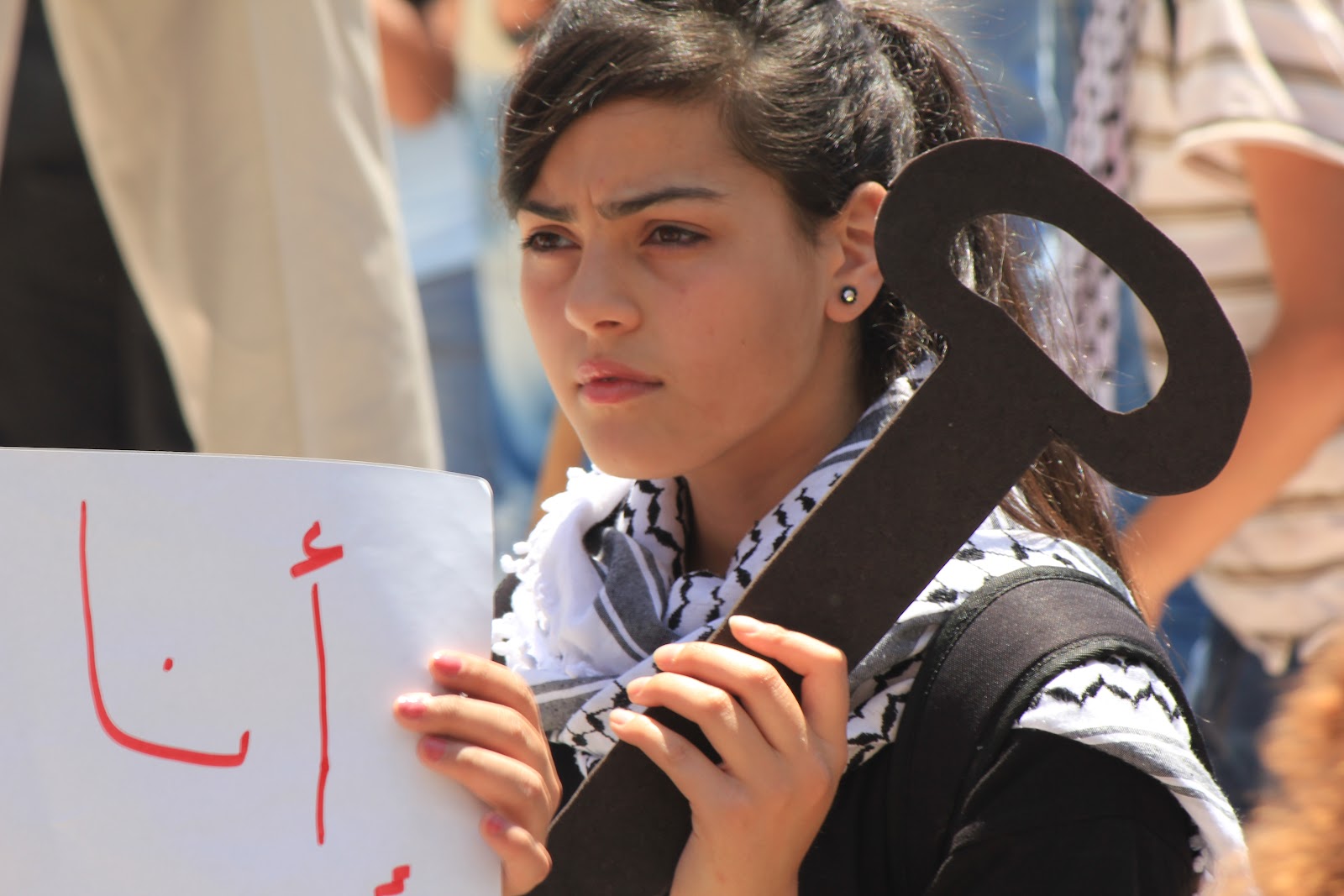
From UN Resolution 194, adopted December 11, 1948 (one day after the UN adopted the Universal Declaration of Human Rights):
“Resolv[ing] that the refugees wishing to return to their homes and live at peace with their neighbours should be permitted to do so at the earliest practicable date, and that compensation should be paid for the property of those choosing not to return and for loss of or damage to property which, under principles of international law or in equity, should be made good by the Governments or the authorities responsible.”
In addition to Resolution 194, the rights of refugees are upheld in many instruments of international law, most notably the 1951 Geneva Convention Relating to the Status of Refugees, as well as numerous other UN resolutions of the Security Council and the General Assembly, the 1976 UN Two-State Solution Plan, the 2004 International Court of Justice ruling, and others.
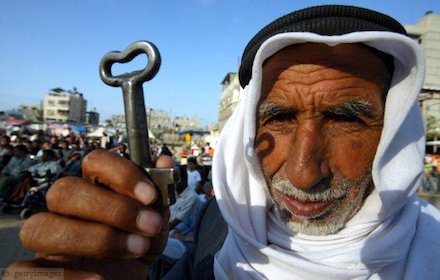 In continuing violation of a large body of international law, Israel refuses to allow the refugees to return or to compensate them for their lost land and property. Six decades after their initial forced displacement from their homeland, Palestinian refugees and IDPs still lack access to lasting solutions and reparations (which include return, restitution, compensation) based on international law, UN resolutions and best practice.
In continuing violation of a large body of international law, Israel refuses to allow the refugees to return or to compensate them for their lost land and property. Six decades after their initial forced displacement from their homeland, Palestinian refugees and IDPs still lack access to lasting solutions and reparations (which include return, restitution, compensation) based on international law, UN resolutions and best practice.
Assistance, Protection, Reparations
Refugees and internally displaced persons (IDPs) have the right to assistance and protection.International assistance and protectionsare required when national authorities are unable orunwilling to act on their obligations. The right of refugees and the obligations of states are set out in the 1951 Refugee Convention.
Assistance includes provision of food, shelter, health and education. Protection activities include ensuring asylum, securing basic human rights, provision of travel documents, and facilitating voluntary durable solutions (repatriation, resettlement, and integration). Repatriation is the only solution that is a right.
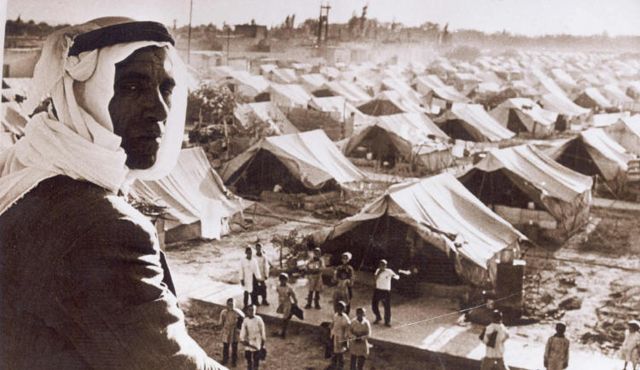
All persons displaced as a result of gross violations of human rights law and war crimes are also entitled to remedies and reparations. The right to a remedy and reparation is enshrined in the law of state responsibility.
In the aftermath of the 1948 Nakba, a special regime for assistance, protection and reparations was set up for Palestinian refugees. The regime was initially composed of the UN Conciliation Commission for Palestine (UNCCP) and the UN Relief and Works Agency in the Near East (UNRWA) and eventually included the UN High Commissioner for Refugees (UNHCR).
The UNCCP was mandated to provide protection to Palestinian refugees, including the search for durable solutions and reparations, but failed and effectively ceased to operate in the mid-1950s. UNRWA is mandated to provide assistance to 1948 and, on an emergency and temporary basis, 1967 Palestinian refugees and to those displaced as a result of subsequent hostilities. Although UNRWA has enhanced its protection activities by means of a rights-based approach to assistance and emergency operations, there remains a lack of protection for Palestinian refugees, especially for those living in UNRWA’s area of operation (Lebanon, Syria, Jordan and the OPT).
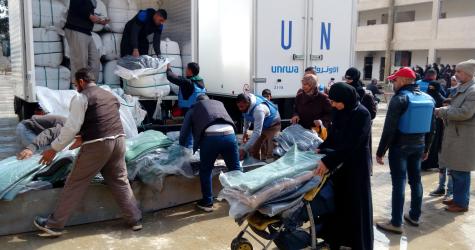
UNRWA faces many difficulties in implementing its mandate due to funding shortages and armed conflicts in the region, in particular Israel’s military occupation. Outside UNRWA’s area of operations, UNHCR is the international agency responsible for providing both assistance and protection to Palestinian refugees. Palestinian refugees are often denied the rights guaranteed under the 1951 Refugee Convention when they seek asylum. National protection of 1948 and 1967 Palestinian refugees in particular has been ineffective as a result of non-application or misinterpretation of Article 1D of the 1951 Refugee Convention by national authorities and courts
No international agency has a mandate to provide assistance and protection for internally displaced Palestinians in Israel. In the OPT, UNRWA and other international organizations may provide limited temporary emergency assistance to some IDPs but no comprehensive and predictable response exists
No international agency, moreover, is searching for comprehensive durable solutions, including reparations, for Palestinian refugees. UNHCR and UNRWA believe that the search for durable solutions should be undertaken by parties to the conflict
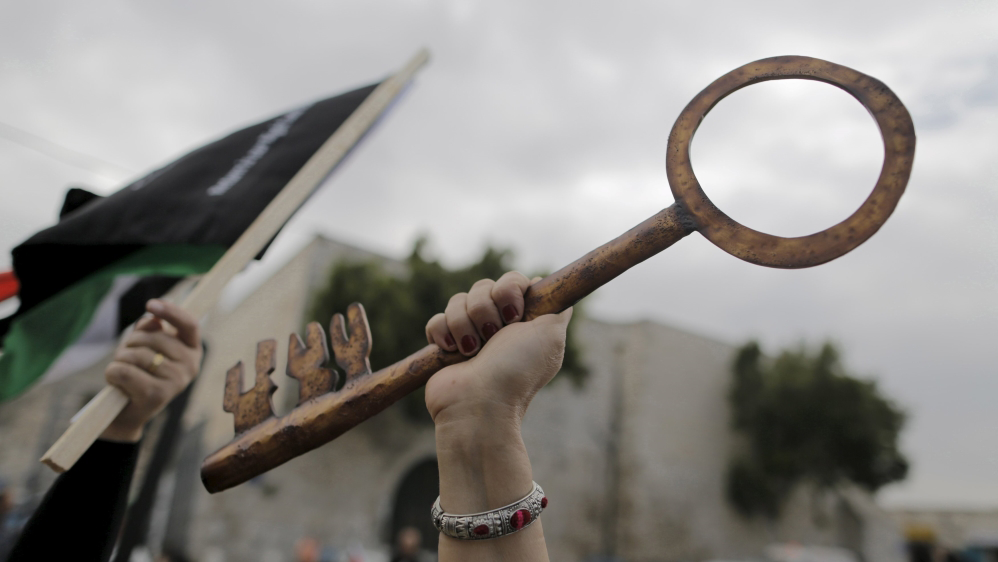 Unlike most refugees and displaced persons, who usually seek protection against forcible return, the primary problem facing Palestinian refugees is Israel’s denial of their right to reparations, including return, to their homes of origin. Although this right is enshrined in international law and affirmed by many UN resolutions, in particular UN resolutions 194 (1948) and 237 (1967), it has not been enforced. Displaced Palestinians have no access to courts that could provide effective remedies and reparations.
Unlike most refugees and displaced persons, who usually seek protection against forcible return, the primary problem facing Palestinian refugees is Israel’s denial of their right to reparations, including return, to their homes of origin. Although this right is enshrined in international law and affirmed by many UN resolutions, in particular UN resolutions 194 (1948) and 237 (1967), it has not been enforced. Displaced Palestinians have no access to courts that could provide effective remedies and reparations.
Resources
PRINT RESOURCES
For more information on Displaced Persons, see our Home Demolitions/Forced Displacement page.
AFSC – Occupation Realities: Palestinian Refugees, 2004 – 2 pp.
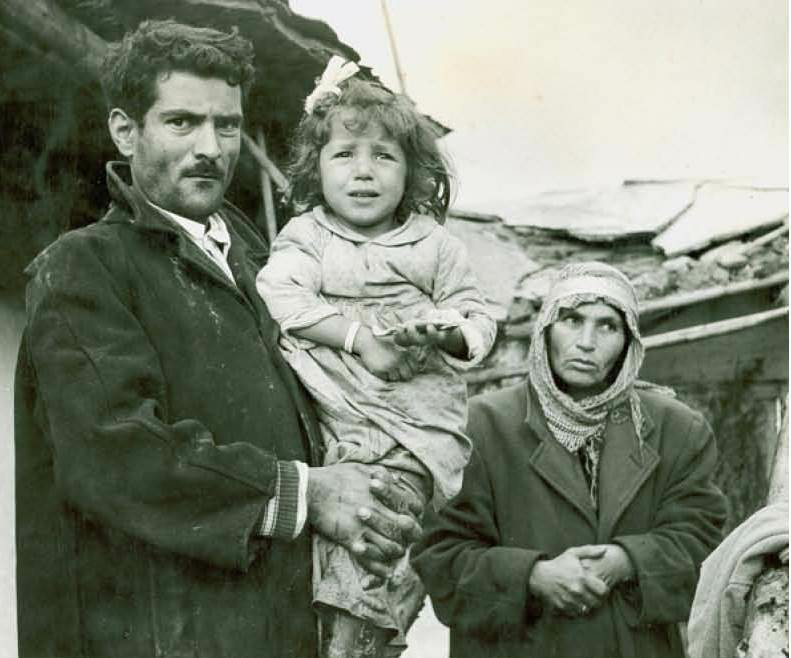 Al-Shabaka
Al-Shabaka
PDF: Bartering Palestine For Research – 4 pp.
PDF: Decades Of Displacing Palestinians, How Israel Does It – 5 pp.
PDF: Invisible Community, Egypt’s Palestinians – 4 pp.
PDF: Palestinian Refugees From Syria, Stranded on the Margins of the Law – 6 pp.
PDF: Palestinian Refugees In Lebanon – 6 pp.
PDF: Palestinians On Road To Damascus – 6 pp.
PDF: Price Of Statelessness, Palestinian Refugees From Syria – 5 pp.
PDF: Refugees, Israeli Apartheid’s Unseen Dimension – 3 pp.
PDF: Uneasy But Necessary, UNRWA-Palestinian Relationship – 5 pp.
PDF: Unwelcome Guests, Palestinian Refugees In Lebanon – 7 pp.
AMP – PDF: Refugees, Introduction – 1 pg.
BADIL
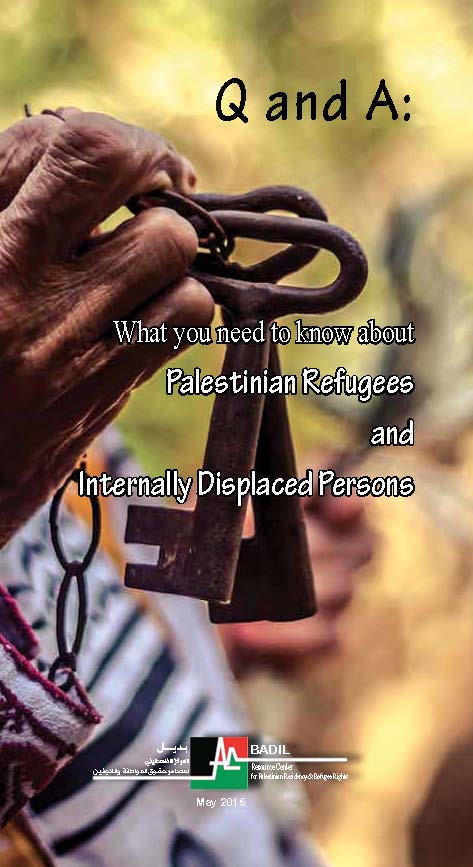 PDF: Factsheet, Assistance Protection Reparations – 2 pp.
PDF: Factsheet, Assistance Protection Reparations – 2 pp.
PDF: Factsheet, Backgrounder on Refugees and IDPs – 2 pp.
PDF: Legal Analysis, Refugees Right Of Return – 21 pp.
PDF: Meaning of UN Resolution 194, Right Of Return – 6 pp.
PDF: Q & A, 2015, What You Need To Know, Refugees and IDPs – 40 pp.
PDF: Q & A, 2008, What You Need To Know, Refugees and IDPs – 25 pp.
PDF: Rights Of Return, International Law – 8 pp.
NAD – PDF: Palestinian Refugees – 5 pp.
NAD – PDF: Refugees – 1 pg.
NAD – PDF: Return And Compensation – 7 pp.
PHROC – PDF: Nakba At 67, Statement 2015 – 2 pp.
Rabbi Brant Rosen – PDF: Why I Support Palestinian Law Of Return – 5 pp.
UNHCR – PDF: Q & A, 1951 Convention on the Status of Refugees and1967 Protocol – 16 pp.
UNHCR – PDF: Text – 1951 Convention And 1967 Protocol, Status Of Refugees – 56 pp.
UNRWA – PDF: Who Are Palestine Refugees – 6 pp.
PHOTOS / VIDEOS / GRAPHICS
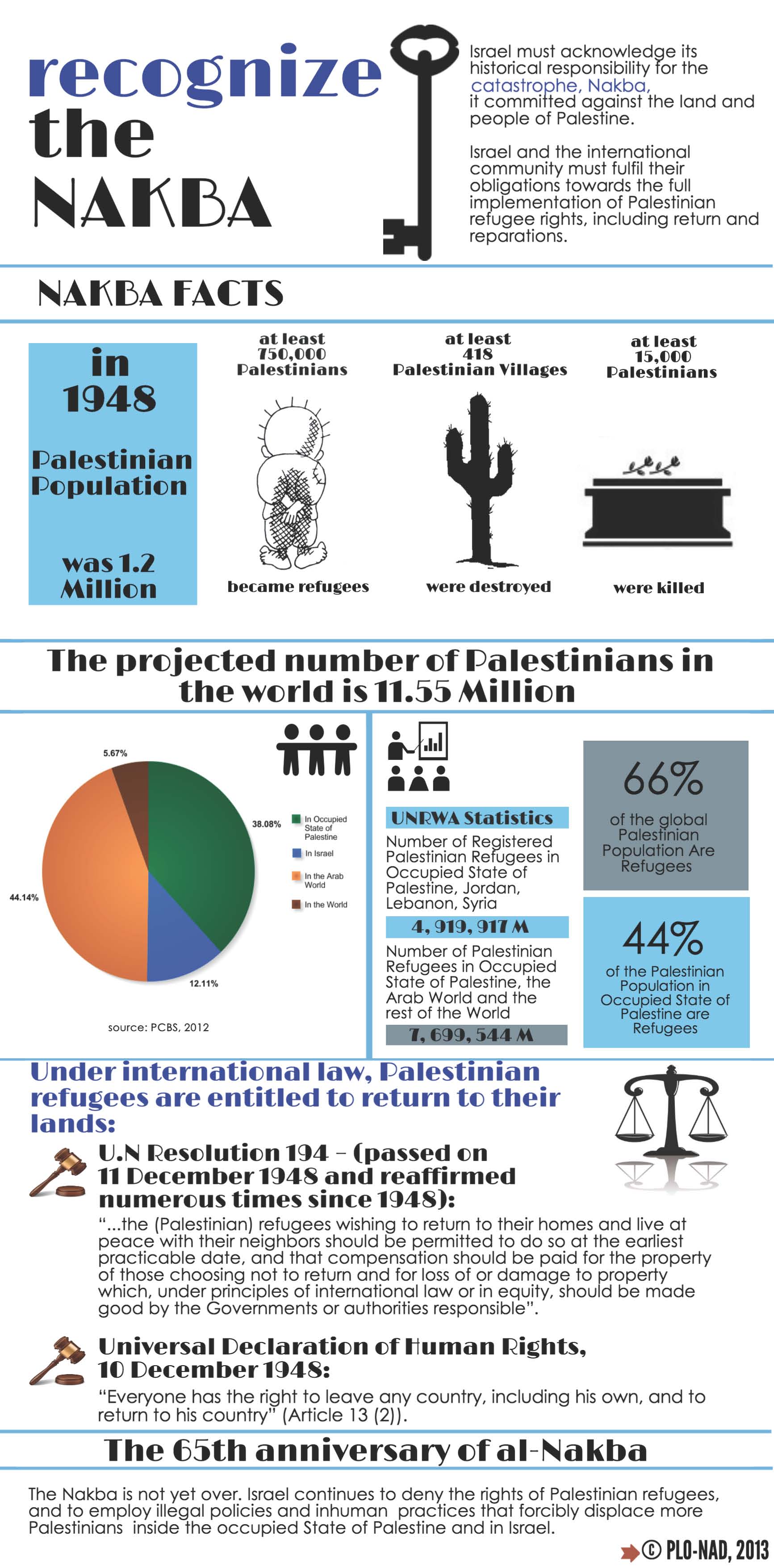 NAD – Infographic: Recognize The Nakba
NAD – Infographic: Recognize The Nakba
UNRWA Gallery of their work: https://www.unrwa.org/galleries/photos
UNRWA Film and Photo Archive, a testament to the resilience and steadfastness of Palestine Refugees https://unrwa.photoshelter.com/index
Includes these galleries:
01. Historic Milestones/Emergencies, 02. Education, 03. Health, 04. Relief and Social Services, 05. Microfinance, 06. Camp Improvement, 07. Protection, 08. Special Events, 09. Press Conferences, 10. Donor Events, 11. Other
UNRWA Videos for Launch of Video Archive
https://www.unrwa.org/content/videos-launch-digital-archive
One of UNRWA’s leading early photographers, George Nehmeh, is featured in the following series of short videos, produced specially for the UNRWA Archive digitization project. The videos feature examples of Nehmeh’s work, along with the explanatory features “where they are now” and “the story behind the icon”.
Remembering Service: UNRWA in Gaza
Remembering Pain: The Massacre at Shatila
Remembering the Journey: The Road to Baqa’a
Remembering Childhood: A Photo Shoot in Khan Younis
Remembering Resilience: A Visit to Bureij



